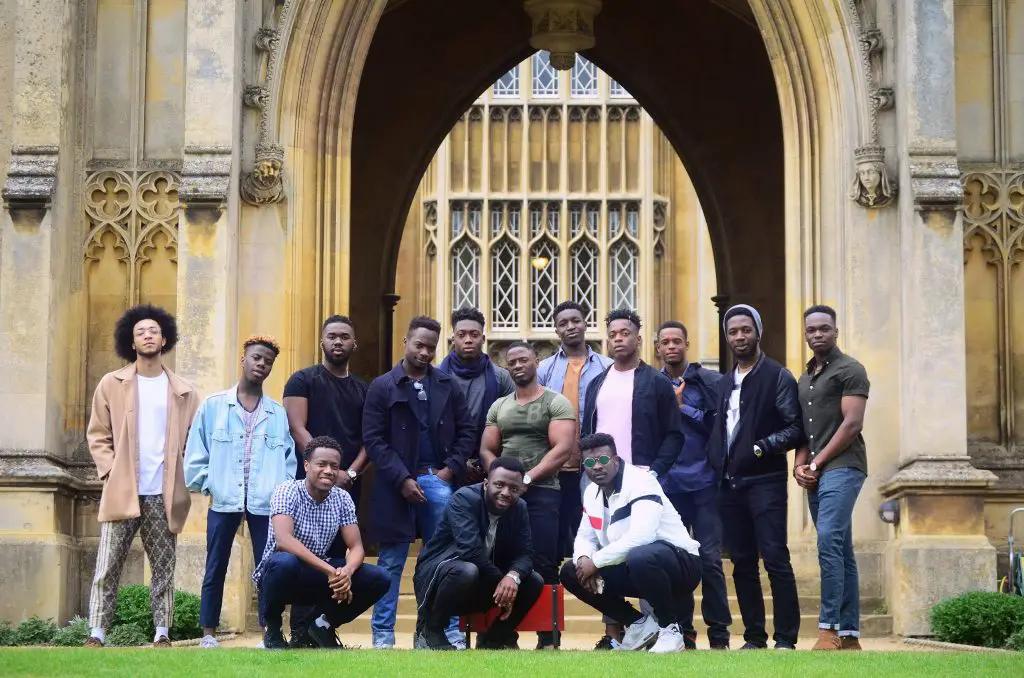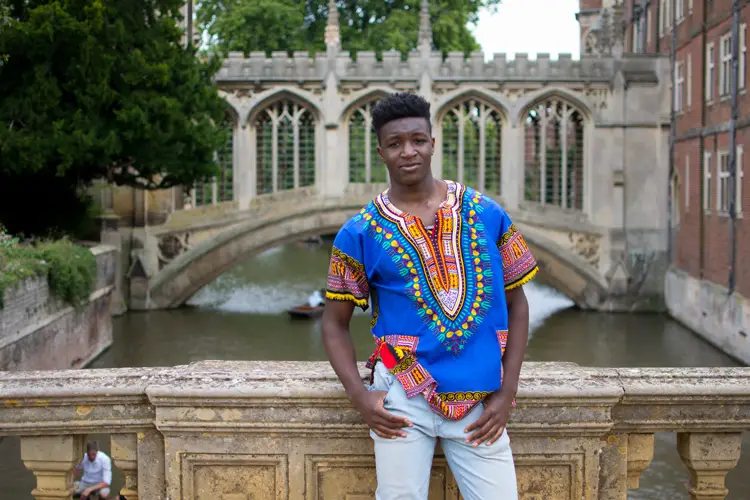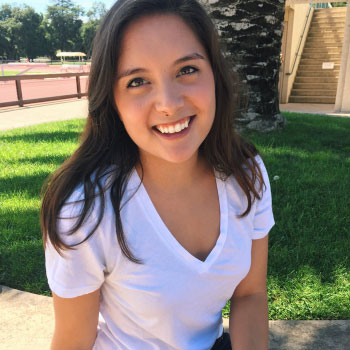For people of color (POC), the struggle to find representation in predominantly white spaces is a universal one. At work, in schools, in art and in academia, it’s easy for minorities to feel keenly alone.
In his freshman year at Cambridge University, in Cambridge, England, student Dami Adebayo experienced an acute feeling of underrepresentation, when he realized that out of his class of more than 2,500 students, only 14 of the men were black.
While Adebayo may live thousands of miles away from the U.S., his experience resonates with many students of color at top universities, an issue to which he and other members of the African Caribbean Society (ACS) wanted to draw attention.
Inspired by Yale student Akintunde Ahmad’s recent, highly publicized tweet that depicted the paucity of black men at the New Haven university, Adebayo and the other male members of the ACS shot a photo similar to Ahmad’s, an image that soon went viral as a result of how poignantly it portrayed the school’s lack of diversity.
As a result of the photo, Adebayo has become somewhat of a figurehead in the debate surrounding diversity at prestigious universities. Though the racial climates of the U.S. and the UK differ, students in both countries are pushing barriers in their pursuit of greater racial equality.
As in the United States, activists in England are calling for systemic changes, a demand that they claim is justified, in part, by statistics such as Cambridge’s lopsided acceptance rates, which reveal that only 17 percent of black-identifying students were granted admission to the university, which is about half of the school’s acceptance rate for white students; many black students even recall being told by their high school teachers to not to apply to top-tier universities.
While the U.S. also struggles with the anemic number of students of color at top universities, Adebayo points out that American universities are leading the way in diversifying their student bodies, a trend that has heartened the Cambridge student in his own activist efforts.

On a more psychological level, Adebayo feels that part of the problem stems from the fact that many young black boys are led to believe that such elite institutions are not “for them,” a mentality that the data reflects. Last year, of the 9,950 students who applied to Cambridge University, only 302 were students of color, just around 3 percent of the applicant pool. Adebayo feels that in order to see the number of minority applications rise, the message about higher education that black youth are receiving must change.
Giselle Krachenfels: You famously took a photo with the fourteen other black male students in your class. Could you tell me more about the image in terms of what inspired it and how people reacted to it?
Dami Adebayo: The idea came from the ACS president, Ore Ogunbiyi, who came up with it after seeing the Yale photograph. She thought it would have a big impact on this side of the world, because in the States, at this point in time, I feel that [representation] is less of an issue than it is here. As soon as Ore reached out to a couple of ambassadors about the idea of doing it, it wasn’t even a question. We jumped straight in.
The message was really about empowerment. A lot of the stuff in the media, and the general way of tackling this issue, sometimes has a negative connotation around it—aggression, pain and anger and whatnot. We really wanted it to be a completely positive message. We’re not trying to argue about what’s fair and what’s not. We’re just saying that if you’re a black student, you can make it here. You should be trying to reach the highest that you possibly can. You shouldn’t have anything that you don’t think is “for” you or places where you don’t think you would fit in. We’re trying to empower the black youth.
GK: How has your experience at Cambridge been? Do you feel like it’s a comfortable place for minorities and POC?
DA: Personally, yes. That’s because I was born and raised in Scotland. Where I was raised, apart from my family, there were a lot of white people around us, so I was very used to it. I moved to South Africa when I was about nine years old, and I went to an international school.
Through going to an international school and seeing a lot of diversity, I learned a lot about different cultures and different people. After that, I came back to the UK and went to another international school, which means that I’ve had a lot of experience being in diverse locations, as well as locations that are less so, like Scotland.
Cambridge is a university, so you will likely find some people like you. However, I know that a lot of my black friends don’t like it, because the number of black students here, or ethnic minorities in general, is incredibly low in comparison to what it should be. There’s a stereotype about Cambridge, not just about it being white, but about it being posh white people.
In some ways, you’re bound to meet those people here, but at the same time, there are so many different types of people. But again, we do feel that people of color, people from different backgrounds and minorities aren’t being represented enough as they should or could be.
GK: Do you feel like the university makes a strong effort to encourage minority students in terms of scholarships and outreach? I’m really more familiar with the U.S. system.
DA: When you compare the two, the U.S system is much further ahead in terms of scholarships, not just to do with people coming from poor backgrounds, but there are also music scholarships, sports scholarships, etc. You guys take it a lot more seriously, because there are more resources on hand.
In the UK, they aren’t offered as much. A lot of people think that [affordability] is the underlying issue, because then [diversity] becomes a financial thing, where people from less affluent backgrounds can’t afford to go to university. There is the student loans system though, which is fairly good if you’re a British student. Obviously, if you’re not British, you can’t get that, and for international students the fees are about three times as expensive.

GK: Do you think that the lack of POC representation affects the college applicant pool?
DA: For sure. I mentioned earlier that I came from a diverse background, so I didn’t really have many worries about that part. But at the same time, when I was applying, I was pretty doubtful. I was thinking, “Should I even apply?” And that’s me, someone who considers themselves very international and open to new things. So if I was doubtful, then I know many other minorities and people of color would also be doubtful, because there really are some discouraging stereotypes. Even after I had accepted my place and decided I was coming, there was still a thought in the back of my head: “Am I really going to like anyone here?”
I think that’s a big issue, and it’s the main motivation behind what we’re doing in trying to change that and say that there are normal people here. That’s one of the things that I always tell people. Even with my aunties and uncles, when I talk to them about Cambridge, they raise their eyebrows and go, “Ooh Cambridge,” and it’s like, relax. They’re just normal people. They might be intelligent, but they still are normal people.
GK: I know this is a big question, but on the applicant side, what do you see as the main issues to address?
DA: From my side, it’s really just about doing whatever we can to change the stereotype and almost, I want to say, normalize success for minorities. You don’t see enough about role models of black backgrounds in the news.
You might see them in sports, you might see them in music, and growing up, those are the types of things I looked up to. It goes beyond race—it’s the basic principle of if you see someone like you doing something, then you’re (more likely) to aspire to be like them. If you’re a British person and you see a British person somewhere, say, in Asia, you’ll be like, “Oh, I can go there too, there’s another British person thriving just fine.”
A lot of black kids are from inner-city London, where they might not come from the best background and Cambridge just isn’t seen as somewhere that they could end up. They maybe don’t see a life for themselves beyond where they are. I think it’s about getting out there and doing whatever we can to change any type of stereotype and about how it’s not cool to be smart, which is something I think is super important to get rid of.
GK: Could you speak a little more about that stereotype?
DA: Thinking of myself growing up and also my black friends, from a young age, we saw a stereotype for black kids that you’re only good at sports. Why can’t we be good at both sports and school?
What I see from the United States is really exciting, because you see, for example, at Harvard, that the incoming year of undergraduates is going to have more non-white students than white students. That’s incredible. Whereas here at Cambridge the supposedly impressive statistic was that, for the first time, there were more black boys as incoming students than Eton graduates as incoming students. Eton is a very famous, prestigious all-boys high school that’s stereotyped as posh. And that’s just from one school! To see that being celebrated was annoying.

GK: Although the two experiences are obviously radically different, what is your perspective on some of the differences between the experiences of black students in the U.S. versus in the UK?
DA: It depends on the university. At universities in London, there are a lot more black students. Their experiences could be more comfortable in the sense that there are people around them who look like them.
At Cambridge and Oxford, which are the two best universities in the UK, the amount of black students is quite low. The sense I get from talking to people is that their experiences are very similar to the African-American experience where you often hear stories about being marginalized.
I feel that part of that has to do with us not being used to it. Sometimes it’s not just about the situation being unfair. Sometimes you have to take the onus on yourself. At the end of the day, the world is never going to give you something. Once you’re in a situation, you have to make do with it. That’s just my personal take on it.
In general, I think the experiences are quite similar. Obviously, the difference in the States is that there are a lot more African Americans. You’re a lot more isolated over here. In terms of culture, at times, I don’t think that British culture is as ruthless. I’m not sure if that’s the right word, but a lot of the news stories you hear coming out from the States just seem ruthless. Over here it’s not as bad. It’s still bad, but I wouldn’t say it’s on that level. Again, this is just my view. A lot of people may feel that it is equally bad [in the UK], if not worse.
GK: Do you feel that high schools work to encourage students of color to apply to these prestigious universities or extend extra help? If so, is this common?
DA: I was lucky enough to go to a private, international school. From my side, it was pretty much a level playing field. A lot of my friends who came from schools that were less well off than mine said it was a lot more difficult. I’ve heard crazy stories. There was one about teachers telling black kids to not even bother applying, that there was no point. There are definitely a lot of restrictions in that way, and a lot of the issues lie with that.
The number of black applicants is really low; I think less than three hundred out of about ten thousand undergraduate applicants. You can pinpoint an issue there, because it’s almost like black students just aren’t applying. But then, obviously, you also look at the acceptance rate for black applicants, and it’s about half of what it is for white kids, so there are so many factors. It’s really daunting to try to face. How do you tackle it? Where do you start?
GK: Do you think that universities in the UK feel an impetus to encourage minority applications? In recent years, some schools in the U.S. have definitely felt that sort of pressure and responded to it. Might UK schools do the same?
DA: Up until now, I would say no. It’s things like this photo that hopefully get the process started. We’re putting pressure on the university. I think that’s what made situations better in the States, because it’s been like that for a while, there’s been a lot of pressure. We’re trying to do the same. We’re asking: What can we do? What can the university do? We want to ensure that we work together during that process. It’s not the same, in terms of the pressure. The race conversation in the States is so much more active than it is over here.

















